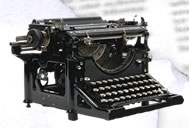Attached is the concluding essay from a U.S. Army report written in 1986 concerning the spirited defense that was offered by the
101st Airborne Division
at the Battle of the Bulge.
"At Bastogne, well-coordinated combined arms teams defeated uncoordinated armored and infantry forces committed to an unrealistic plan."
Another article about this battle can be read by clicking here...
The American magazines that appeared on newsstands during late November and early December of 1944 are often found to have articles anticipating life in the post-war world or tips on how to welcome your returning husband home from the battle fronts. This line of thinking was put on hold in late December when the Germans launched their brutal counter offensive through the Ardennes Forrest in what has been nicknamed "the Battle of the Bulge".
This is the 1947 review of Robert Merrian's history on the Battle of the Bulge,
Dark December; the reviewer, T.E. Cassidy, had served as a U.S. Army intelligence officer in the Ardennes:
"Merriam is at his best analyzing the actual confusion that was rampant from the very beginning of the German drive on December 16th. I know his handling is expert here, for I was in the midst of the chaos, and can vividly recall, for example, the blank stares I met at various headquarters when I would ask what road net was clear, and to what point. It was really no one's fault, after the first day or two. People simply did not know what was happening. And it was days and days before there was any concerted agreement among the different levels as to just what was going on."
YANK correspondent, Sergeant Ed Cunningham, filed this report concerning all that he saw during the earliest stages of the German counter-attack in Bastogne; some Americans were leaving, some were staying, new ones were arriving - and all the while the Belgian townsfolk watched in confusion and hoped for the best.
The attached paragraphs tell the story of General Patton's famous prayer for battle weather - who authored it and how many men recited it.
"That prayer [and the accompanying Christmas] greeting were typically Patton. They [read as if they] were [pulled] from the Old Testament rather than the New and had the ring of Joshua and David at their militant best. They were not written for a soft time but for their occasion; they were words to make men strong - and they did."
FDR's D-Day prayer can be read here
Here is a short column that lists the impact that the American counterattack wrought upon the German forces as a result of their winter offensive during the Battle of the Bulge - no explanation was given as to how this information was attained.
"The Battle of the Ardennes was practically over. The salient which once poked 52 miles into Belgium from the German frontier had been ground down to a nub by last week.... The German retreated slowly and in good order. In the sleet and fog of the Ardennes they pulled back their armor and other vehicles while their artillery and infantrymen put up stiff rearguard actions."
"Men slept on their rifles to keep them from freezing. On bitter mornings they urinated down the barrels of automatic weapons to thaw them out... Some Yanks cut holes in their sleeping bags, wearing them underneath their overcoats and knee-length snow capes while sleeping and fighting."
Here is the NEWSWEEK MAGAZINE account of the defense of Bastogne during the Battle of the Bulge (December 16, 1944 - January 25, 1945). The article opens with a thorough explanation of General McAuliffe's famous response to the German officers who came in search of an American surrender.
The greatest deception deployed by the German Army during the the Ardennes Offensive was to parachute Nazi commandos into the American lines - men who had been raised in the U.S. and spoke the language well. They wore American uniforms and performed heinous acts of sabotage, and as this article spells out, lured many GIs to their deaths.
Two of these Germans attempted to kidnap and assassinate General Eisenhower, click here to read about it...
This article follows the efforts of the Tank Destroyers (TD) in the Ardennes during the Battle of the Bulge:
"This TD work is among the most dangerous of the war. One of the chief reasons is that TDs are constantly up against superior enemy weapons. For example, none of our TDs (except possibly the M-36) can penetrate the 8-inch frontal armor of the King Tiger, whereas the German 88-millimeter anti-tank gun has been able to penetrate any American tank. And to kill the tiger, TDs must shoot for the tracks, then assault the disabled monster with high explosive, setting it afire."
Click here to read about the equipment and training of American tank destroyers during the Second World War.
As the Battle of the Bulge reached its conclusion and the Germans resumed their retreat, British General Bernard Law Montgomery (1887 – 1976) held a press conference in which he praised the fighting abilities and the leadership skills of all those Americans who resisted the German onslaught in the Ardennes:
"But when all is said and done, I shall always feel that Rundstedt was really beaten by the good fighting qualities of the American soldier..."
"Nobody tried to deny it. The Germans had achieved perhaps the most valuable of military advantages - surprise. How did they do it? [In these two articles] Allied officers gave some obvious reasons, but critics guessed at some that were less obvious."
